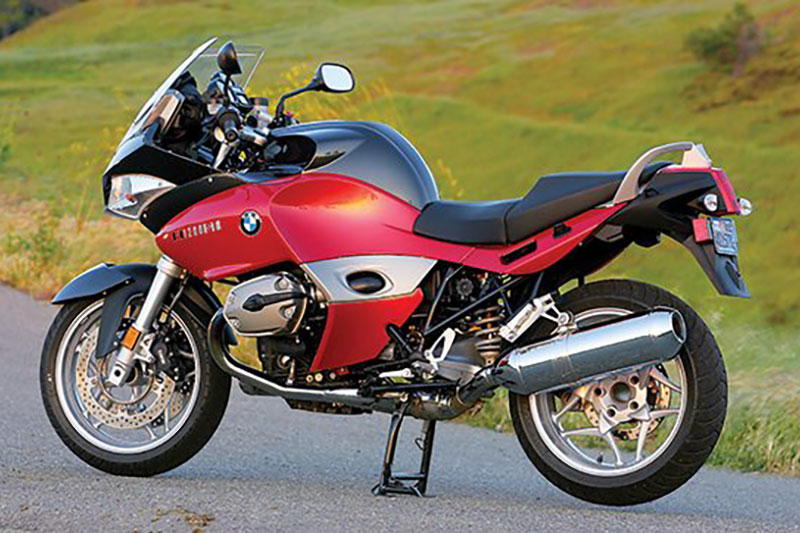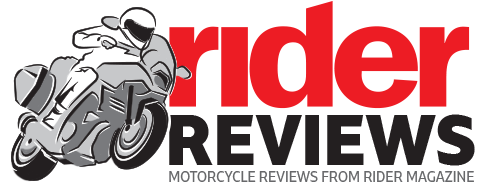2005 BMW R1200ST

Road Test Review
The “ST” designation on a motorcycle usually indicates a sport tourer, one that offers a melding of some degree of sporty handling with various touring capabilities including hard-shell, removable saddlebags. A wide variety of bikes have carried that designation, including the very sleek but heavy Honda ST1300 with its V-4 engine and Triumph’s revised in-line triple (see page 28), and Ducati has offered several V-twin models including the ST2, ST3 and ST4S. While many BMW models fall along the ST curve, previously only one model has carried that designation, the R80ST back in the ’80s.
All STs are not alike. A given model may bias itself toward the sporting end by delivering lightness and performance at the expense of touring comfort—like the Ducati ST4S. Or, like the Honda ST1300 and most BMWs, it may provide great touring comfort and wind protection, but with sporting pretensions limited by weight, engine performance or both.
If you’re the kind of rider who feels that to earn its ST a bike must offer very high marks in sporting power, suspension quality, braking and stability, along with true touring comfort, wind protection and the rest, you’ll be pleased that BMW has gotten it very nearly right with its R1200ST. This new 2005 model supersedes the R1150RS, which was biased much more toward touring comfort than sporty performance. With its demise, and that of the K1200RS, for the first time since 1977 BMW no longer has an RS (rennsport or “race sport”) in its lineup.
The R1200ST is the third model in the new R1200 oilhead boxer series for 2005 that also includes the RT and GS; the R1200 cruiser line has been dropped for ’05. All three R1200 models utilize the new version of the 1,170cc air/oil-cooled flat-twin engine with two spark plugs and four valves per cylinder. As with all oilhead BMWs, the ST’s engine functions as a stressed member; various subframes solidly mount to it to support the fork, seat and related components. This is BMW’s first flat twin series to use a balance shaft to combat vibration.
While boosting displacement from 1,130 to 1,170cc, BMW left the bore at 101mm, but stroked the engine 2.5mm to 73mm. A single cam in each head actuates the four valves per cylinder through short rocker arms and screw-type lash adjusters; exhaust valves are now sodium filled for enhanced heat transfer. While the previous R1150 series also used BMW’s Two-Spark system with dual plugs per head, both plugs fired together. On the new R1200s the BMS-K engine management system can fire the spark plugs independently for greater combustion efficiency.
Do all these changes work? Indeed! When we tested an R1150RS in our July 2002 issue it generated 83.1 rearwheel horsepower and 67.4 lb-ft of torque on the dyno. For this test, the dyno indicated that the new R1200ST generated 95.3 peak horsepower at 7,600 rpm, and 74.2 lb-ft of torque at 6,250 rpm. Those are increases of about 15 and 10 percent respectively, which complements the new bike’s lighter weight quite nicely.
Not all R1200 engines are the same. While those in the RT and ST models are identical and utilize a 12.0:1 compression ratio, the GS model offers 11.0:1. That factor, combined with cam, engine management and other changes, gives the RT and ST about 12 more horses than the GS, which generated 83.2 horsepower and 73.1 lb-ft of torque when tested in our January 2005 issue. The new pistons are lighter than before, and the engines utilize under-piston oil jets for better cooling and greater oil flow. The engine needs no choke; simply turn the key and hit the starter, hot or cold, and the bike launches into its lumpy, big-twin idle. Settle into the bike to find rather firm grips that place you in a comfortable but leaned-forward crouch. One of BMW’s hallmarks since the introduction of the R1100RS for the 1994 model year has been adjustability, and the ST offers an adjustable windshield, handlebars and rider’s portion of the seat. Remove the passenger portion, and the rider’s portion may be placed in either a high or low position. To do so, set an aluminum bar in the correct slot up front, then slide the rider’s seat forward so that its slots mate with it and the appropriate rear adjusters. It’s very simple, requires no tools, and allows for a seat height of either 30.7 or 32.6 inches.
Each individual clip-on style handlebar can be slid down the fork tubes about an inch by loosening a Torx-style bolt (the wrench is supplied in the meager toolkit). We found the highest setting most useful, and wished for more adjustment in the higher direction.
The seating position is sporting without being extreme, and the shape of the seat allows for easy weight shifts. At first the seat feels cushy, plush, but soon the rider notes that it borders on mushy. The passenger’s step is so far rearward that most riders will not feel limited by it.
The hydraulically actuated clutch has a light pull. On the road that six-speed transmission is a delight that shifts lightly and easily, as well as or better than any BMW in memory. While the rider can feel the opposed-twin throb in the grips, the engine is relatively smooth to around 4,600 rpm, at which point the throbbing vibration becomes obtrusive; however, this corresponds to more than 80 mph and while it moves into the footpegs, too, it does not become any worse on up to the bike’s 7,500-rpm redline. Riders who spend a lot of time strafing corners will wish for less vibration, though the bike is smooth on the highway.
Underway the ST feels comfortably light, compact, mass-centralized. BMW has put its bikes on a rigorous weight-loss program, and at 525 pounds wet the ST is 27 pounds lighter than its predecessor—while also making significantly more power—which is the source of this ST’s noticeable new sporting capabilities. Another factor is that sixth gear is now lower for added passing power, but there will be some tradeoff in fuel economy.
Unique to BMW are the Telelever fork and Paralever driveshaft, which aid tremendously in handling stability. The revised Telelever A-arm is lighter and stronger than the unit it replaces; its forward end attaches to a ball joint on the fork brace. Because of its geometry the Telelever feeds braking forces into the main frame rather than the fork tubes, which results in greater stability and very little fork dive under heavy braking.
The single-sided Paralever driveshaft/swingarm prevents braking or throttle inputs from being fed into the suspension, and has also been redesigned. It is stronger, stiffer and lighter, and now carries its torque arm on top for greater cornering clearance. The Paralever cancels out the usual up/down motion of a conventional driveshaft, allows the rear end to stay relatively level despite hard acceleration and braking, and is a major contributor to the bike’s excellent stability. In concert with the Telelever this unique suspension system helps to retain both suspension travel and cornering clearance so that the bike stays relatively level during hard riding.
Our dyno chart shows that the bike has a high-end hit like no previous stock BMW twin. To better handle its power the ST’s frame geometry is slightly different from the RT’s. Its 59.1-inch wheelbase is slightly longer than the RT’s, and the ST also offers 0.4-degree greater steering-head angle and 0.7 inches more trail.
The new shock absorber features TDD, or “travel-dependent damping.” The idea is that its compression damping increases as the shock compresses. It’s adjustable for both spring preload (with an easily accessed hand wheel) and compression damping. Get this bike a-rockin’ on a mountain road and it feels precise, well-damped, with very stable and predictable steering, its lean angles nicely dialed in via the Michelin Pilot Road radial tires, a 120/70-ZR17 front and 180/55-ZR17 rear.
BMW pioneered anti-lock braking systems (ABS) for motorcycles, and its current system is a further improvement. Its servo actuation (essentially a power brake system for motorcycles) was introduced on the R1150 series, and was justly criticized for its overly aggressive actuation in most riding circumstances, and for that annoying servo whine at stops.
The upgraded system on the R1200ST, however, is a major step forward as BMW has done away with the excessive actuation and whine. Both front four-piston calipers feature an electric power-assist mechanism that comes on powerfully, yet modulation is similar to that of conventional braking systems. Stops are powerful and well controlled, but without that former grabbiness. The semi-Integral system is also linked front to rear; actuating the front brake lever also applies the rear’s two-piston caliper. The rear pedal actuates only the rear brake. Brake too hard for conditions, and the ABS system releases hydraulic pressure immediately, preventing lockup, then re-applies it many times per second for a secure stop.
While the ST is marvelously functional in most every performance category, it disappoints in upper-body wind protection—a category in which a sport tourer should excel. Its windscreen slides on a pair of tracks and is manually adjustable within a 1.5-inch range. While hand protection is adequate, even with the screen in its highest position the wind strikes the rider at about collarbone level. We expect that larger aftermarket windscreens will be a popular item for ST owners. Also, the bike offers virtually no underseat storage.
In fairness, however, we’ve got to add that the ST excels in other touring capabilities: its two-position (optional) heated handgrips are wonderful, and should be standard on every bike. While I was riding in a driving rainstorm turning to snow, the welcome heat from the grips radiated all the way to my elbows. The ST offers the aforementioned adjustability, plus that standard power outlet for heated clothing or a battery charger. BMW’s excellent locking saddlebags are optional, along with a luggage rack, trunk, tankbag and other amenities. The tank cover is plastic, so a strap-on tankbag is needed.
The most controversial aspect of this bike is its unorthodox styling, and how its multiple planes, angles and surfaces interact or conflict. No matter how you feel about those stacked headlights, they throw a major amount of lumens. To us, its front end has the appearance of a rather large Euro-scooter. Craig Vetter, the inventor of the Windjammer fairing and numerous other products back in the 1970s, once told me that a design that looks really new and different today will appear dated in a very short time. In my opinion, the ST’s front end falls within that category; your opinion may be different.
The ST’s 5.5-gallon tank offers good fuel capacity, and with our average 43.5-mpg usage it results in a very acceptable range of 239 miles. Because of the 12.0:1 compression ratio, the ST requires a minimum of 91-octane fuel.
At $14,990 the 2005 R1200ST is priced $900 less than the model it replaces. However, a closer reading of the price list reveals that such items as anti-lock brakes ($995), the chromed muffler ($125) and heated handgrips ($200) are optional. We expect that the vast majority of STs delivered to U.S. dealers will, like our test bike, already be equipped with these items, which means that few (if any) bikes will actually be available at that base price; ours priced out at $16,310.
If you’re one of those riders who likes STs in general for their relative long-distance comfort, fuel capacity, hard-shell saddlebags and sporting pretensions, BMW has just given you one more reason to love its new ST—true sportiness. Its lightness, power and handling make it one of the most balanced and well-formed packages in the genre; it just needs that slight boost in comfort level to be perhaps the best balanced sport tourer on the market.
